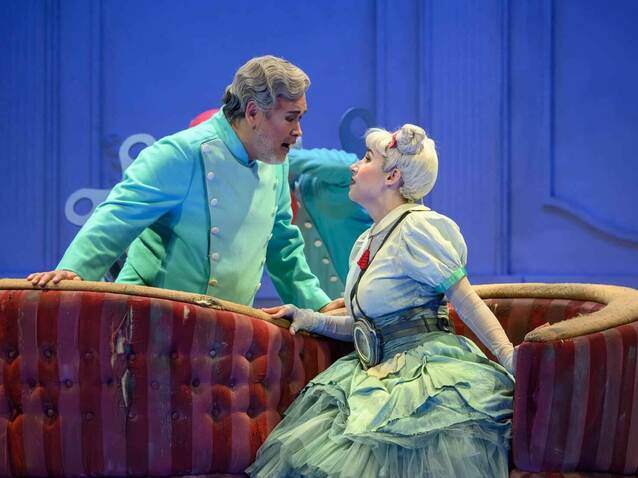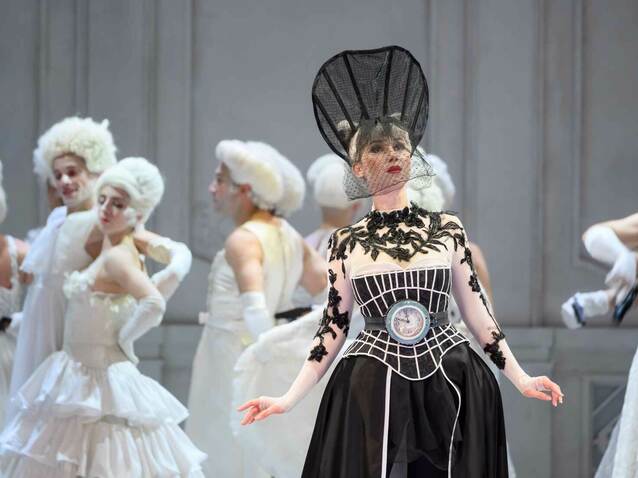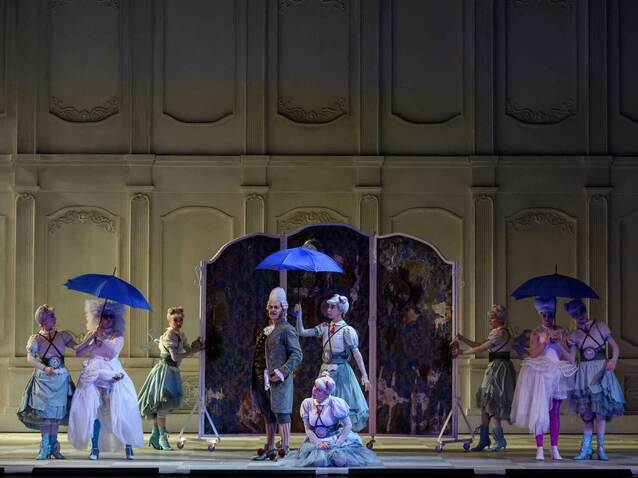 © A. Bofill / Liceu
© A. Bofill / Liceu
La Cenerentola, even more than Il Barbiere di Siviglia, is the true encyclopaedia of Rossinian singing which, in a barbarically summarized form, could be defined as a singing that must be easy, fluid, light, but in no way inconsistent; a line full of high notes to which the interpreter should never arrive puffing, exhausted, strangled and at the limit of their strength after a risky climb, but should fly over it elegantly and lightly, taking advantage of the fact that Rossini never forces the singers to climb to the treble without preparing the ground with adequate previous intervals that allow them to make the final leap to the top without difficulty. The Rossinian interpreter will never be short of fiatto (which would make it very ugly), and the coloratura, fiouriture, abellimenti, volatine, roulades and other agilities will never be presented as a dangerous gymkhana of notes with uncertain endings, but perfectly integrated into the tempo, without ever delaying it. We must not forget, too, that Rossini does not stop at the agilities and that we will also find, and especially in La Cenerentola, the canto spianato where it will be necessary to demonstrate that the singer knows how to link the sound in an expressive way.
All this, and more, we had in the excellent Cenerentola that was presented at the Liceu after more than sixteen years without appearing its stage.
We must begin with the expert and effective conducting of Giacomo Sagripanti who gave a sparkling, luminous, transparent and joyful Rossini with very lively tempi. The sonority of the orchestral ensemble was balanced between sections and there was also balance of dynamics between pit and stage. La Cenerentola is one of the Rossini titles that offers more concertante passages that often run at a devilish pace. Here too, Sagripanti triumphed and managed to make the concertante passages come together well, without losing lightness and flexibility. The orchestral performance was very good, with a sound of great quality, and the male section of the Cor Madrigal (in this opera there is no female choir) was also very good, replacing the Liceu choir, which is currently preparing Fidelio.

La Cenerentola - Gran Teatre del Liceu Barcelona (2024) (c) A. Bofill
Angelina, the "Cinderella", the title character, is a role for a mezzo-soprano who masters coloratura. Maria Kataeva, making her debut at the Liceu, gave a spectacular performance. The Russian mezzo-soprano has agility, beautiful vocal color and rises to the treble without fear or problems but can also descend to a full-bodied, cozy and velvety bass that embraces you and handles the dynamic regulators very well. Given her high performance throughout the work, there was great expectation to hear her final "Nacquì all'affano", her great moment of brilliance and she certainly did not disappoint, on the contrary.
Javier Camarena is clearly evolving towards a more lyrical voice, with more weight in the centre, perhaps in the future he will not be able to sing the role of Prince Don Ramiro which is very clearly for a light tenor, a tenore di grazia. However, at this moment Camarena is at the exact point to make an anthological Don Ramiro. The singing is not transparent, it already has a nice consistency, but it still unfolds with impressive ease. Camarena placed the fearsome high C's of "Sì, ritrovarla io giuro" with confidence, courage and ease and thrilled the audience.
Baritone Florian Sempey was also sensational as Dandini, the servant who spends most of the opera impersonating the prince. The role requires a baritone who flies over a forest of short notes, sings them without turning everything into a sonorous slide and must also transmit with an affected singing in an extravagant -but not ridiculous- way that we are before a character who pretends to be who he is not. Achieving this nuance of a servant who tries to sing like a prince is very difficult and Sempey thoroughly succeeded.
Don Magnifico is another difficult, strenuous and demanding role that needs a basso buffo parlante with impeccable articulation to overcome the exhausting ostinatos over repeated semiquavers that Rossini often assigns to old coot characters to accentuate their ridiculousness. Paolo Bordogna survived quite well the dizzying sillabato Rossini forces on him to make the audience laugh. His performance was satisfactory although a little more vocal projection would have been desirable.
Soprano Isabella Gaudi and mezzo-soprano Marina Pinchuk played the roles of Clorinda and Tisbe, Angelina's wicked stepsisters, very well. They are the real "Cinderellas" of La Cenerentola because they are on stage for almost all the opera and do not stop singing, but in the end all the glory goes to Angelina and the tenor with whom they have not been able to marry.
Alidoro, the prince's mentor, despite being a relatively minor role presents a fearsome aria "Là del ciel nell'arcano profondo". The role is ideal for a basso profondo, Erwin Schrott, who is more of a bass-baritone, did not seem to feel vocally comfortable in the character, yet he resolved it quite well.

La Cenerentola - Gran Teatre del Liceu Barcelona (2024) (c) A. Bofill
All that musical excellence was applied to a production from the Rome Opera by Emma Dante. The actress and director from Palermo respects globally the original sense and spirit of Rossini's work, who, honouring his condition of "enlightened" man, enemy of superstition, had already expelled from the work all the magical and supernatural elements of Perrault's tale (including the mice and the pumpkin), had changed the stepmother for a stepfather and had transformed the fairy into a wise and kindly tutor.
Bullying and domestic violence, the "dark side" that all fairy tales have and that Rossini's work maintains, are underlined in Dante's stage direction. She accentuates it and brings it to the forefront, but not to the point of distorting the work or altering its initial purpose of moral education.
Visually, what we find on stage when the curtain rises is a world of pastel colours that, in a naïf aesthetic code, is located in an original cross between Disneyland, Barbie, a dollhouse and a patisserie concept of scenery and costumes.
During the first half hour everything is very cute, naive, cheerful, colourful and fun, especially because the main characters unfold into an army of funny mechanical automatons. Halfway through the opera one begins to fear that the automatons, which are no longer funny because of too much repetition, are going to be around for a long time, and finally one ends up wishing that the automatons’ cogs and gears would get stuck and stop because they are just annoying. This is what usually happens with many naïf proposals: they shine a lot but soon wear out.
Xavier Pujol
Barcelona, May 18th, 2024
La Cenerentola by Gioacchino Rossini. Javier Camarena, tenor. Florian Sempey, baritone. Paolo Bordogna, bass-baritone. Isabella Gaudí, soprano. Marina Pinchuk, mezzosoprano. Maria Kataeva, mezzosoprano. Erwin Schrott, bass-baritone. Orchestra of Gran Teatre del Liceu. Madrigal Choir. Conductor, Giacomo Sagripanti. Stage director, Emma Dante. Restaging, Federico Gagliardi. Scenography, Carmine Maringola. Costumes, Vanessa Sannino. Lighting, Cristian Zucaro. Choreography, Manuela Lo Sicco. Production by Teatro dell'Opera di Roma. Gran Teatre del Liceu.
the 22 of May, 2024 | Print
Comments